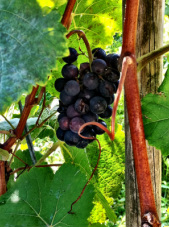Red Wine Grapes
Merlot
"If anybody orders Merlot, I'm leaving..." If any film did less to promote Merlot than Sideways, then I've not seen it! But before we completely rule out Merlot, let's consider that it's the main grape in two of the world's most expensive and sought after wines: Chateau Cheval-Blanc from St Emilion and Chateau Petrus from Pomerol. And without it, Bordeaux wouldn't be making much wine. That said, Merlot from Bordeaux is probably not that representative of the single varietal Merlots you may be ordering in bars, which are much more likely to come from the new world. I don't think too many of my readers are going to be delighting in the Petrus or Cheval Blanc anytime soon, but you can definitely find Merlot from all over, that's easy to drink, fruity and simple. Jancis Robinson describes it the Chardonnay of reds!
Some facts about Merlot:
If you like# Merlot but fancy something a little bit different, you might try Chilean Carmenere. Much of it was originally sold as Merlot as the plantings weren't well controlled or identified.
- Merlot's primary character is not a flavour, it's a texture. It's smooth, soft and when blended with Cabernet, will iron out the rough edges
- My favourite Merlots are probably not that useful to you, coming from Ticino in Switzerland. Back in my Swiss living days, it was a tasty and food friendly treat, but I don't think they'll be stocking it in Tesco any time soon.
If you like# Merlot but fancy something a little bit different, you might try Chilean Carmenere. Much of it was originally sold as Merlot as the plantings weren't well controlled or identified.
Cabernet Sauvignon
This is a dark black grape with a thick skin, so you'll find red wines from this aromatic grape to be distinctive in it's general "blackcurrant" flavours and also its high levels of tannin and acidity. But what does that mean to you? Well, simply put, Cabernet Sauvignons tend to be pretty "big" wines - they have a thick mouthful, fully body and sometimes almost chewy tannins. It's perhaps not a "beginner" wine though, despite it's popularity.
A few facts about Cabernet Sauvignon:
Cabernet Sauvignon is definitely a grape that is worth paying a little more for if you like full bodied wines. The wines age very well and if you have the right environment at home, wines in bottle from the better sites will improve for 10-20 years. While I wouldn't suggest trying that with a bottle of Wolf Blass Yellow Label, that's a reasonably priced example that will start your Cabernet Sauvignon journey.
A few facts about Cabernet Sauvignon:
- It's the biggest part of the blend in most of the Left Bank wines of Bordeaux. These are wines from some of the oldest and most prestigious chateaux in France, such as Chateaux Lafite, Mouton-Rothschild, Latour and Margaux.
- Napa Valley in California is the new home of Cabernet. At a blind tasting in France as far back as the 70s, Californian Cabernets beat the Bordeaux wines, as judged by French judges. If you've got plenty of money to spare, Opus One is definitely worth a try and if you're filthy rich with amazing trade contacts, you may one day dream of trying Screaming Eagle. (I'm still waiting). For a premium yet still affordable Napa Red, Stag's Leap offer great quality and value.
- You'll not be mistaken if you pick up mint, cedar or green pepper flavours from a Cabernet. This means it probably came from a cooler climate, whereas hot climate versions might even give you a hint of black olive or turn the signature blackcurrant into blackcurrant jam. Great examples of this might be found in Australia eg Coonawara or Margaret River.
- New Zealand (Hawke's Bay) and Chile (Colchagua) are also gathering a gaining reputation for producing classic Cabernet Sauvignons.
- Like many of our most favourite grape varieties, Cabernet Sauvignon is actually a crossing between two other grapes - originally it came from a planted seed from a Cabernet Franc cross-pollenated with Sauvignon Blanc.
Cabernet Sauvignon is definitely a grape that is worth paying a little more for if you like full bodied wines. The wines age very well and if you have the right environment at home, wines in bottle from the better sites will improve for 10-20 years. While I wouldn't suggest trying that with a bottle of Wolf Blass Yellow Label, that's a reasonably priced example that will start your Cabernet Sauvignon journey.


